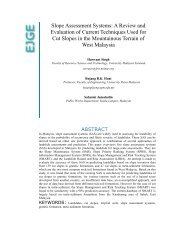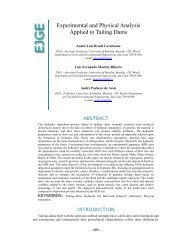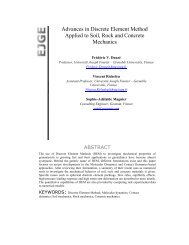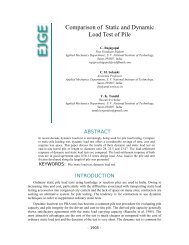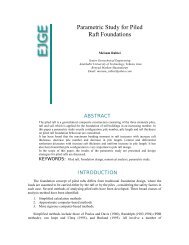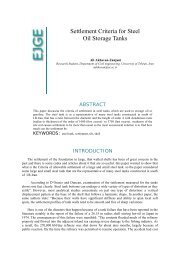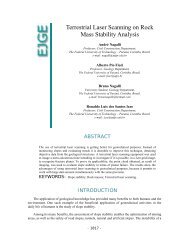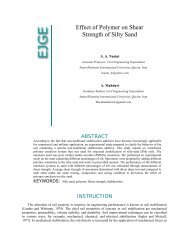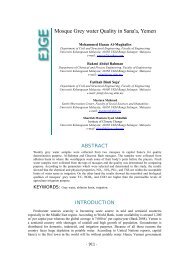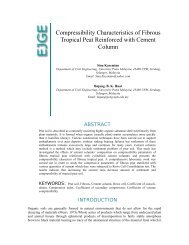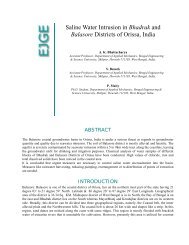Effect of Soil Confinement on Ultimate Bearing Capacity ... - Ejge.com
Effect of Soil Confinement on Ultimate Bearing Capacity ... - Ejge.com
Effect of Soil Confinement on Ultimate Bearing Capacity ... - Ejge.com
You also want an ePaper? Increase the reach of your titles
YUMPU automatically turns print PDFs into web optimized ePapers that Google loves.
Vol. 12, Bund. E 2<br />
INTRODUCTION<br />
In recent years Civil Engineering pr<str<strong>on</strong>g>of</str<strong>on</strong>g>essi<strong>on</strong>als have adopted the practice <str<strong>on</strong>g>of</str<strong>on</strong>g> improvement<br />
<str<strong>on</strong>g>of</str<strong>on</strong>g> soil by reinforcement, <strong>com</strong>pacti<strong>on</strong>, grouting etc. The decreasing availability <str<strong>on</strong>g>of</str<strong>on</strong>g> good<br />
c<strong>on</strong>structi<strong>on</strong> sites has led to increased use <str<strong>on</strong>g>of</str<strong>on</strong>g> sites with marginal soil properties. In view<br />
<str<strong>on</strong>g>of</str<strong>on</strong>g> this, the requirement for in situ treatment <str<strong>on</strong>g>of</str<strong>on</strong>g> foundati<strong>on</strong> soil to improve its bearing<br />
capacity has risen markedly. The soil c<strong>on</strong>finement is <strong>on</strong>e such method <str<strong>on</strong>g>of</str<strong>on</strong>g> improving soil<br />
capacity. The more recent advancement in this field is to provide c<strong>on</strong>finement to the soil<br />
by using metalcell, geocell etc. This novel technique <str<strong>on</strong>g>of</str<strong>on</strong>g> soil c<strong>on</strong>finement, though<br />
successfully applied in some areas <str<strong>on</strong>g>of</str<strong>on</strong>g> geotechnical engineering, has not received much<br />
attenti<strong>on</strong> in foundati<strong>on</strong> applicati<strong>on</strong>s. In the last few decades, great strides in the<br />
modificati<strong>on</strong> <str<strong>on</strong>g>of</str<strong>on</strong>g> existing forms <str<strong>on</strong>g>of</str<strong>on</strong>g> foundati<strong>on</strong>s have occurred, al<strong>on</strong>g with the development<br />
<str<strong>on</strong>g>of</str<strong>on</strong>g> new and unc<strong>on</strong>venti<strong>on</strong>al types <str<strong>on</strong>g>of</str<strong>on</strong>g> foundati<strong>on</strong> systems through c<strong>on</strong>siderati<strong>on</strong> <str<strong>on</strong>g>of</str<strong>on</strong>g> soil and<br />
structure interacti<strong>on</strong>. This results in a system that is more realistic in performance,<br />
utilizing the form and material strength. Lateral c<strong>on</strong>finement <str<strong>on</strong>g>of</str<strong>on</strong>g> cohesi<strong>on</strong>less soil is <strong>on</strong>e<br />
<str<strong>on</strong>g>of</str<strong>on</strong>g> them. Many researchers have studied the effect <str<strong>on</strong>g>of</str<strong>on</strong>g> lateral c<strong>on</strong>finement <strong>on</strong> bearing<br />
capacity, especially <strong>on</strong> sandy soil. They have c<strong>on</strong>cluded that by c<strong>on</strong>fining the soil there is<br />
a reducti<strong>on</strong> in the settlement, and hence there is an increase in the bearing capacity <str<strong>on</strong>g>of</str<strong>on</strong>g> the<br />
soil.<br />
Rea and Mitchell (1978) c<strong>on</strong>ducted a series <str<strong>on</strong>g>of</str<strong>on</strong>g> model plate loading tests <strong>on</strong> circular<br />
footings supported over sand-filled square-shaped paper grid cells to identify different<br />
modes <str<strong>on</strong>g>of</str<strong>on</strong>g> failure and arrive at optimum dimensi<strong>on</strong>s <str<strong>on</strong>g>of</str<strong>on</strong>g> the cell. Mahmoud and<br />
Abdrabbo (1989) presented an experimental study c<strong>on</strong>cerning a method <str<strong>on</strong>g>of</str<strong>on</strong>g> improving<br />
the bearing capacity <str<strong>on</strong>g>of</str<strong>on</strong>g> strip footing resting <strong>on</strong> sand sub-grades utilizing vertical<br />
n<strong>on</strong>extensible reinforcement. The test results indicate that this type <str<strong>on</strong>g>of</str<strong>on</strong>g> reinforcement<br />
increases the bearing capacity <str<strong>on</strong>g>of</str<strong>on</strong>g> sub-grades and modifies the load–displacement<br />
behavior <str<strong>on</strong>g>of</str<strong>on</strong>g> the footing. Khing et al. (1993) investigated the laboratory-model test results<br />
for the bearing capacity <str<strong>on</strong>g>of</str<strong>on</strong>g> a strip foundati<strong>on</strong> supported by a sand layer reinforced with<br />
layers <str<strong>on</strong>g>of</str<strong>on</strong>g> geogrid. Puri et al. (1993) studied the ultimate bearing capacity <str<strong>on</strong>g>of</str<strong>on</strong>g> strip and<br />
square foundati<strong>on</strong>s supported by sand reinforced with geogrid. Das and Omar (1993)<br />
presented the ultimate bearing capacity <str<strong>on</strong>g>of</str<strong>on</strong>g> surface strip foundati<strong>on</strong>s <strong>on</strong> geogrid-reinforced<br />
sand and unreinforced sand. Dash et al. (2001b) investigated the use <str<strong>on</strong>g>of</str<strong>on</strong>g> vertical<br />
reinforcement al<strong>on</strong>g with horiz<strong>on</strong>tal reinforcement .The reinforcement c<strong>on</strong>sisted <str<strong>on</strong>g>of</str<strong>on</strong>g> a<br />
series <str<strong>on</strong>g>of</str<strong>on</strong>g> interlocking cells, c<strong>on</strong>structed from polymer geogrids, which c<strong>on</strong>tain and<br />
c<strong>on</strong>fine the soil within its pockets. Schimizu and Inui (1990) carried out load tests <strong>on</strong> a<br />
single six-sided cell <str<strong>on</strong>g>of</str<strong>on</strong>g> geotextile wall buried in the subsurface <str<strong>on</strong>g>of</str<strong>on</strong>g> the s<str<strong>on</strong>g>of</str<strong>on</strong>g>t ground.<br />
Mandal and Manjunath (1995) used geogrid and bamboo sticks as vertical<br />
reinforcement elements and studied their effect <strong>on</strong> the bearing capacity <str<strong>on</strong>g>of</str<strong>on</strong>g> a strip footing.<br />
The strength <str<strong>on</strong>g>of</str<strong>on</strong>g> c<strong>on</strong>fined sand has been studied by Rajagopal, Krishnaswamy and<br />
Latha (1999).They studied the influence <str<strong>on</strong>g>of</str<strong>on</strong>g> geocell c<strong>on</strong>finement <strong>on</strong> the strength and<br />
stiffness behavior <str<strong>on</strong>g>of</str<strong>on</strong>g> granular soils. Dash et al. (2001a) performed an experimental study<br />
<strong>on</strong> the bearing capacity <str<strong>on</strong>g>of</str<strong>on</strong>g> a strip footing supported by a sand bed reinforced with a<br />
geocell mattress. Several authors have also studied strip foundati<strong>on</strong>s but reinforced with<br />
different materials such as steel bars (Milovic, 1977; Bassett and Last, 1978; Verma<br />
and Char, 1986), steel grids (Daws<strong>on</strong> and Lee, 1988; Abdel-Baki et al.1993 ;),<br />
geotextile (Das,1988), and geogrids (Milligan and Love, 1984, 1985; Ismail and<br />
Raym<strong>on</strong>d, 1995). Sawwaf and Nazer (2005) studied the behavior <str<strong>on</strong>g>of</str<strong>on</strong>g> circular footing <strong>on</strong>



